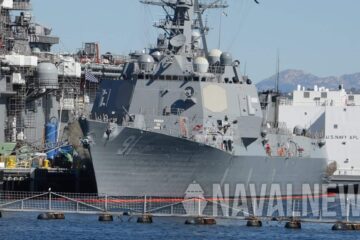Raytheon press release
This award follows the Navy’s decision to shift from development to production on the enhanced intermediate-range, surface-to-air missile, placing the Block 2 variant on track for initial operating capability in 2020.
The ESSM missile is the primary ship self-defense missile aboard Navy aircraft carriers and large deck amphibious assault ships. It is an integral component of the Navy’s layered area and ship self-defense capability for cruisers and destroyers.
“ESSM plays a critical role in protecting navy sailors worldwide and our international partners share our commitment to evolve this missile,” said Dr. Mitch Stevison, Raytheon Strategic and Naval Systems vice president.
ESSM is the foundation of several allied navies’ anti-ship missile defense efforts and is operational on almost 200 naval platforms worldwide.
The ESSM program is a cooperative effort managed by a NATO-led consortium comprising 12 nations: Australia, Belgium, Canada, Denmark, Germany, Greece, The Netherlands, Norway, Portugal, Spain, Turkey and the United States.

Naval News’ comment
ESSM is a medium-range, all-weather, semi-active radar-guided missile used in surface-to-air and surface-to-surface roles. ESSM represents more than four decades of technology and design improvements by a 43-year international cooperative partnership composed of 12 nations, 10 of which employ ESSM (and FMS to 3 countries: Japan, UAE and Thailand).
As a tail-controlled missile, ESSM uses enhancements to its guidance system to take advantage of improved seeker sensitivity, increased propulsion and greater weapon accuracy. These features enable ESSM to arrive at the intercept point with more endgame speed and agility to counter the threat.
ESSM’s capability bridges the gap between close-in air defense and local area defense systems. Its kinematics result in reduced time to target. It is a Multi-mission weapon system is effective against high-speed or low-velocity threats.
According to open sources, the RIM-162 Evolved SeaSparrow Missile (ESSM) has a range of about 27 nautical miles (50 Km) and a top speed of Mach 4+.
Unlike Block 1, Block 2’s active radar homing seeker will support terminal engagement without the launch ship’s target illumination radars. The improved ESSM Block 2 will be fielded by the US Navy from 2020.






